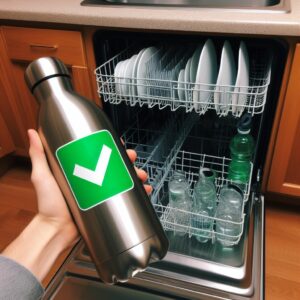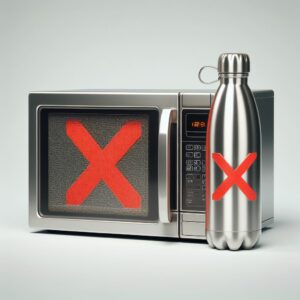I often get questions from friends about whether Stanley bottles are truly safe for daily use. It’s a fair question—we want to ensure our trusted hydration companion doesn’t leach scary chemicals into our water over time.
After digging into Stanley’s materials, manufacturing, and safety testing, I can confidently vouch that Stanley bottles meet rigorous standards for health and well-being. Here’s an in-depth look at why these iconic vessels deliver safe, worry-free hydration you can feel good about.
Introducing Stanley and Their Safety Standards
First, some Stanley basics. Founded in 1913, Stanley has over a century of expertise in engineering rock-solid durability into drinkware built to last. They got their start crafting indestructible steel vacuum flasks.
Today, Stanley applies the same obsessive standards to craft water bottles that excel at keeping water optimally pure and delicious. They engineer each component not just for resilience but also for user health.
Stanley prioritizes safety at every step, from material selection to manufacturing checks. Their legendary build quality gives us peace of mind that Stanley = safety.
The Materials That Make Stanley Bottles Safe
From medical-grade stainless steel to BPA-free plastics, Stanley only uses materials that optimize purity and resilience for safe hydration. Rigorous testing ensures quality control too. You can trust Stanley’s material selection.
Stainless Steel: From durable food-grade alloys to polished, non-porous interiors, stainless steel is ideal for inert water contact.
BPA-Free Plastics: Lids and accessory components utilize only BPA- and BPS-free plastics to prevent leaching.
Powder Coat: Vibrant exterior powder coats contain no harmful VOCs or chemicals.
FDA-Compliant: All materials adhere to FDA standards for food and beverage contact and contain no toxins.
This meticulous material selection enables safe use and lifetime durability. But how exactly does Stanley ensure safety?
Adhering to Strict FDA Safety Standards
As the authority ensuring food and beverage safety, the FDA sets stringent rules. Stanley bottles meet or exceed all FDA criteria:
- NSF Certified: Tested and certified as food-safe for direct consumable contact.
- LFGB-Compliant: Adheres to German standards for food purity and quality.
- Prop 65-Compliant: Contains no carcinogens or reproductive toxins under California law.
- Independent Lab Testing: Confirms the bottles contain no harmful chemicals or heavy metals.
With full FDA compliance, you can trust Stanley bottles won’t endanger your health or wellness.
Why Stainless Steel is Ideal for Safe Drinking

As Stanley’s primary material, stainless steel provides pure water contact. The non-porous steel prevents odor and taste retention. Naturally antimicrobial, stainless steel also resists germs. It’s perfectly safe for direct consumable contact.
- Non-Porous: The dense, non-absorbent steel prevents odors, stains, and tastes.
- Naturally Inert: Stainless steel won’t degrade or leach compounds into water over time.
- Antimicrobial: The chromium in steel boasts natural germ-resistant properties.
- Pollutant-Free: Medical-grade steel contains zero contaminants or preservative residues.
- Flavor Neutral: Won’t impart metallic or unpleasant flavors, even when brand new.
Thanks to these stellar stainless steel attributes, it’s the ultimate safe and pure material for drinking vessels.
How Stanley Water Bottles Avoid Harmful BPA
Stanley rigorously lab tests all products to ensure 0% BPA or other harmful chemicals are present. Independent third-party verification guarantees no exposure to the dangers of BPA. You can drink confidently knowing Stanley’s BPA-free commitment.
- 100% BPA-Free: Every bottle component and material is independently lab-certified BPA and BPS-free.
- Third-Party Verified: Stanley seeks outside validation to ensure there is absolutely no BPA content.
- Ongoing Testing: Bottle materials undergo regular testing to re-verify BPA’s absence over time.
This attentive effort ensures no exposure to the hormone-disrupting dangers of BPA. You can drink easily.
No Other Harmful Chemicals Are Present in a Stanley Water Bottle Either
In addition to being BPA-free, Stanley bottles contain no other concerning chemicals. Independent labs confirm they are also free of lead, phthalates, toxins, and heavy metals. Only safe, pure materials contact your water.
- Toxin-Free: Tested free of lead, DEHP, cadmium, mercury, and other toxic heavy metals.
- Phthalate-Free: Contains no hormone-disrupting plasticizers like DEHP.
- VOC-Free: Uses no volatile organic compounds in coatings that could leach or off-gas.
- Odor/Stain Neutral: The non-retainment steel and polymer lining won’t impart tastes or smells.
You can trust Stanley bottles won’t introduce scary toxins or hidden hazards into your drinking water.
Why Stanley Water Bottles Are Safe For Family Use Too
With pure stainless steel and no hazardous chemicals, Stanley bottles are ideal for family use. Kids won’t ingest any toxic materials or metals that would pose greater risks to small bodies. You can trust Stanley bottles to hydrate children safely.
- Child-Safe: Contains no choking hazards or materials that could harm kids’ development.
- Non-Toxic: Kids won’t ingest any heavy metals or VOCs that pose higher risks to small bodies.
- Hygienic: Antimicrobial steel and thorough washability prevent germ spread.
- Durable: Tough stainless steel bodies withstand rough handling and drops without shattering.
- Insulated: Keeps water cool even if left sitting out by accident.
You can trust Stanley bottles to safely hydrate kids while bringing peace of mind to parents.
How Stanley Water Bottles Prevent Allergic Reactions
Stanley thoroughly avoids all common allergens and irritants in their materials. Their bottles are latex, nut, and food allergen-free. The hypoallergenic steel and polymer materials won’t provoke topical skin sensitivity either.
- Latex-Free: Contains no natural rubber latex that could trigger reactions.
- Nut-Free: Absolutely no nut oil or nut derivative materials are used.
- Food Allergen-Free: No proteins from shellfish, eggs, dairy, soy, or gluten
- Non-Reactive: The inert steel and polymers won’t cause topical skin sensitivity.
Drink in confidence, knowing Stanley bottles are formulated to prevent allergic responses.
Stanley Water Bottle Dishwasher And Microwave Safety
Stanley bottles are engineered to be fully dishwasher-safe thanks to durable steel construction and BPA-free plastics. But you should “NEVER” put a metal water bottle or any metal utensils in a microwave. With reasonable care, Stanley bottle materials maintain integrity across conditions.
- Dishwasher Safe: All parts are fully dishwasher safe using standard cycles. Avoid high heat or prolonged washing.
- Microwave Safe: Stanleys’ stainless-steel bottles and metal utensils should NEVER be put inside of a microwave.
- Impact Resistance: Durable materials prevent cracking or warping from heat or pressure.
- Water Resistance: Leakproof seals withstand humidity and condensation.
Use common sense, when putting anything in dishwashers and microwaves.
Stanley Water Bottles Are Safe With Hot Beverages Too
The food-grade stainless steel is approved for high-temperature food and beverage contact to avoid leaching or contamination. Materials withstand repeated exposure to hot contents without issue. You can trust Stanley bottles with hot coffee or tea.
- Scald Burn Prevention: The insulated exterior prevents exterior burning.
- Textured Grips: Provide a secure hold even when filled with hot coffee.
- Leakproof: Lid seals maintain integrity even with boiling water.
- FDA Approved: Materials meet standards for high-temperature food and beverage contact.
Enjoy hot cocoa, coffee, and tea, knowing Stanley bottles handle the heat safely and responsibly.
Stanley Lids: Engineered For Safety
Far from an afterthought, Stanley lids are thoughtfully designed for safe drinking. Durable BPA-free materials withstand temperature fluctuations and are used without warping or cracking. Leakproof seals keep contents secured. Textured, ergonomic surfaces provide steady, non-slip gripping.
- Leakproof: Tested seals prevent spills and splashing burns.
- BPA-Free Plastics: Inert materials won’t degrade from hot or cold content.
- Shatterproof: Durable polymers withstand drops without cracking.
- Ergonomic: Contoured and textured for steady, non-slip gripping.
- Secure: Buttons and loops secure lids closed when not sipping.
Thoughtfully engineered lids ensure safe, controlled flow while keeping contents secure.
How Stanley Water Bottles Prevent Leaks And Spills
Stanley’s vacuum seal and precisely engineered lid components minimize messy leaks through leakproof friction fit seals, durable materials that won’t crack, and locking mechanisms that secure lids closed when not in use. Redundancies like dual o-rings further ensure water stays inside your bottle, not out.
- Vacuum-Sealed: Maintains pressurization that forces the lid tightly against the opening.
- Impact Resistant: Materials endure jostling and dropping without separating from the bottleneck.
- Snug Fit: Precision manufacturing ensures a tight lid/body interlock.
Whether tossed in a bag or left in a hot car, Stanley lids don’t budge, and contents don’t spill.
Why Stanley Water Bottles Are Safe With Carbonation
The rigid steel construction easily withstands the pressure from carbonated beverages. Precision lids create a gas-tight hermetic seal, keeping carbonated drinks bubbly. Some lids even feature pressure relief spots to vent excess CO2. You can confidently carbonate with Stanley.
- Pressure Withstanding: The steel body easily withstands the internal pressure from carbonated beverages.
- Hermetic Seal: The leakproof lids keep contents fully isolated, maintaining carbonation.
- Impact Resilience: The steel won’t rupture or fragment if dented or dropped when holding carbonation.
You can confidently use Stanley bottles for sodas, beers, sparking water, and similar carbonated drinks with no safety risk.
Stanley Water Bottles Have No Known Health Dangers Or Risks
No adverse health effects are associated with proper Stanley bottle use. Made using food-safe stainless steel approved for medical devices and containing no toxins or leaching hazards, Stanley bottles have a proven track record of providing pure, safe hydration after over 100 years on the market.
- Non-Toxic: Rigorously lab-tested to be free of heavy metals and chemical hazards.
- Medical-Grade Steel: Made using food-safe stainless steel found in food prep and medical tools
- NSF Certified: Meets all health and safety standards for direct consumable contact.
- No Chemical Leaching: The inert materials won’t degrade or release compounds into the contents.
After a century of trusted use, Stanley bottles have a proven track record of providing completely safe hydration with no health compromises.
How Stanley Is Ensuring Ongoing Safety
To guarantee continued safe use of your Stanley bottles:
- Inspect them carefully for any cracks or abrasions in the interior lining that could allow contaminants to enter. Immediately discontinue use if found.
- Check that the rubber gaskets remain supple and intact. Replace dried-out or hardened gaskets as needed.
- Follow Stanley’s care instructions using non-toxic cleaners. Avoid harsh chemicals that could degrade parts.
- Hand-tighten lids firmly but don’t overtighten to prevent seal deformation over time.
With basic safety-focused care, your Stanley bottles will provide pure, untouched water for decades of happy hydration.
Stanley Water Bottles Are Built Safe For Adventure
The pure, medical-grade steel construction makes Stanley bottles ideal for outdoor activities. They maintain water purity when exploring pristine natural water sources. Durable materials withstand harsh backpacking and camping without cracking or leaching chemicals. You can trust Stanley on even the most remote adventures.
- Purity: The non-leaching steel maintains water’s integrity while out in nature.
- Durability: Withstands rough backpacking and camping conditions without cracking or leaking.
- Insulation: Keeps water cool and refreshing all day long, even on scorching hikes.
- Lightweight: Easy to pack without adding excessive ounces and weight.
- Leakproofing: Stanley bottles are designed not to spill a single precious drop over rough trails or rapids.
Bring Stanley bottles anywhere without a second thought—their resilience and purity empower safe hydration even in extreme environments.
FAQs: Common Stanley Safety Questions
Still have lingering questions about Stanley’s safety? Here are answers to frequent concerns:
Are older vintage Stanley bottles safe to use?
Yes, with proper inspection—check for corrosion and replace any cracked gaskets.
Can you put non-water drinks like juice or alcohol in a Stanley bottle?
Absolutely—the non-reactive steel won’t leach or retain flavors over time.
Do small scratches inside the bottle raise safety issues?
Minor scratches are fine. But deep scratches that expose the metal underneath should be avoided.
Should Stanley bottles be replaced after a certain period of use?
There is no set replacement timeframe; with basic care, Stanley bottles can safely last for decades.
Can temperature extremes negatively impact bottle safety?
No – Stanley materials maintain integrity from subzero freezing up to boiling temperatures.
Is it safe to use cleaners like bleach or baking soda?
Avoid harsh cleaners that could degrade parts over time. Use eco-friendly options instead.
Do Stanley lids contain latex or lead?
Absolutely not; all lids are latex and lead-free, using BPA-free plastic and food-grade silicone.
Is an occasional temporary odor or taste transfer cause for concern?
Not at all; thorough cleaning removes harmless, temporary odors. This won’t affect long-term safety.
Is it safe to use a bottle that’s dented or cracked?
Minor dents are fine as long as the interior remains uncompromised. But cracks penetrating both layers necessitate replacement.
In summary, Stanley bottles provide safe and pure hydration thanks to meticulous design, medical-grade materials, and extensive quality control. You can use your Stanley with full confidence that it won’t endanger your health or well-being. Here’s to healthy adventuring!

About Me
I’m Paul Burkhardt, an expert in water and water treatment since 2006 with in-depth experience not only in treating water but also in helping to provide people with healthier, high-quality drinking water.
I’ve helped thousands of people with their drinking water questions, including what kind of water bottle might be best for them and their lifestyle.
If you’d like more information about me, please check out the links below or read more here:



